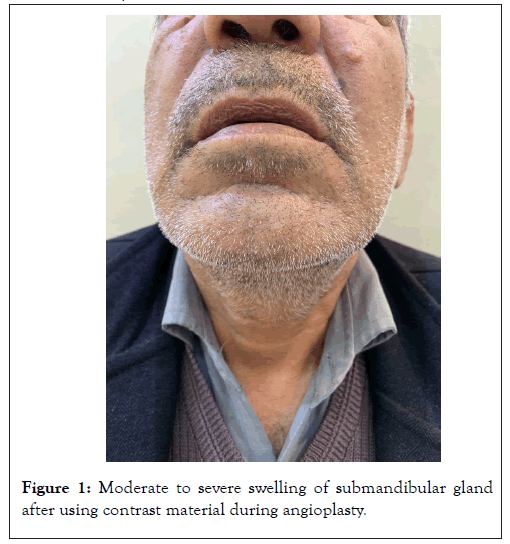Clinical & Experimental Cardiology
Open Access
ISSN: 2155-9880
ISSN: 2155-9880
Case Report - (2021)Volume 12, Issue 7
Iodide mumps is a rare complication after the administration of the contrast agent which presented with unilateral or bilateral swelling of the salivary glands, usually without pain.the treatment of this complication is empiric and also may be reverse without treatment .in this paper we report a rare case of iodide mumps that occurred for the second time after coronary angioplasty
Iodide; Mumps; Angiography
Iodide mumps is a rare complication after the administration of the contrast agent which manifests with unilateral or bilateral swelling of the salivary glands, usually without pain [1]. The pathogenesis of this complication is not yet fully understood but there are three theories for it. Idiosyncratic reactions, toxic accumulation in salivary glands and renal dysfunction [2]. The true incidence of this complication after administration of contrast material is unknown [3]. Currently we aim to present a iodide mumps that occurred for the second time after coronary angioplasty.
A 60-year-old man presented external chest pain and dyspnea (function class Ó? that occurred three years ago and it continues until now. He had history of ischemic heart disease and hypertension. On clinical examination, there was no special mention and vital signs were normal and renal function test was normal. The patient's medical history consisted of aspirin, and to atorvastatin, losartan, nitrocontin and metoprolol. Three years to ago, the patient underwent angiography, that he had bilateral salivary gland swollen that had improved spontaneously within a few days. Three years ago, the patient was advised to angioplasty or Coronary Artery Bypass Graft (CABG), which the patient had refused and continued drug therapy. This time he underwent and angiography for the second time, the patient also had a swollen salivary gland following the use of a contrast agent as in Figure 1, which was resolved with administered methylprednisolone within a few days.

Figure 1: Moderate to severe swelling of submandibular gland after using contrast material during angioplasty.
Contrast material is widely used in intervention procedures in cardiology field [4]. Iodide mumps is a benign complication that lasts from few minutes to 5 days after the administration of the contrast agent [5,6] In addition, other reactions such as swelling of the thyroid gland, mild dysphagia, conjunctivitis, mild stridor and lacrimal gland swelling have also been reported [7-10].
The etiology of iodide mumps is still unknown [2]. In our case the renal function was normal and also the salivary gland swelling was isolated and painless. The most notable point of our case was occurred after second coronary angiography. To our knowledge, to date, only two cases have occurred for the second time after exposure to the contrast agent [10,11]. In our case, iodide mumps occurred with a low dose of the contrast agent in previous exposure in coronary angiography and with a high dose of contrast agent in the second time in coronary angioplasty. This finding suggests that the incidence of this complication is not related to the dose of contrast agent. In the previous case we reported that the patient with a low dose of contrast material developed this complication [12]. The treatment of this complication is empiric, and in some cases it has even improved spontaneously without treatment, however, it the antihistamines and steroids has been used to reverse the glandular enlargement in most of cases [3]. In our case we are the prescribed methylprednisolone to treat this complication. There practical point in the clinical setting that can be deduced from this case is that this complication may also occur in subsequent exposure with contrast material. Therefore, taking history from the patient can be effective in predicting this complication in clinical procedures using contrast media. However, to date no specific treatment has been reported to prevent this complication.
In conclusion iodide mumps is a rare complication after administration of contrast agent that is benign, and recovery occurs shortly with empiric therapy and even spontaneously.
Citation: Mohamadi A (2021) Iodide Mumps Occurs for the Second Time After Coronary Angiography. J ClinExp Cardiolog. 12:690.
Received: 09-Jun-2021 Accepted: 23-Jun-2021 Published: 30-Jun-2021 , DOI: 10.35248/2155-9880.21.12.690
Copyright: © 2021 Mohamadi A. This is an open-access article distributed under the terms of the Creative Commons Attribution License, which permits unrestricted use, distribution, and reproduction in any medium, provided the original author and source are credited.